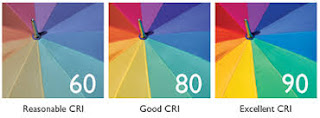Lighting Theory
LIGHTING THEORY
Lighting can be considered in 4
stages, source, flow, illuminance and luminance.
1. SOURCE - the light
source has a luminous intensity (symbol I)
and is measured in candela.
2. FLOW - the flow of
light, or light flux (symbol φ) which
is measured in lumens.
3. ILLUMINANCE (symbol E)
-
when light falls on a surface,
the level of illumination on that surface is referred to as illuminance. The
unit of measurement is lux. (lumens per square metre)
4. LUMINANCE (symbol L)
– The fourth stage of this process is the light leaving the surface which has
been illuminated by the source.
Consider a situation where the
same amount of light strikes both a “dark” surface and a ”bright” surface. The
illuminance is the same in each case but due to the greater reflectance of the “bright”
surface it now becomes a secondary source of light. Its luminance will
therefore be much greater than that of the dark surface. Luminance is measured in lumens emitted per sq.m.
LAWS OF LIGHT
Rectilinear Propagation of light.
This means that light travels in
straight lines.
It travels at 300,000 km/S and
requires no medium for propagation.
Inverse Square Law
The area illuminated by the point
light source increases in proportion to the square of the distance. It
follows that the average illuminance would decrease by the same ratio.
E = I/ d2
where d = the distance between
the source and the object.
Cosine Law
When light does not fall normally
on a surface, the area illuminated increases reducing the average illuminance
by the same ratio.
Fig. 1.13 shows light from a
distant source striking surfaces AB and BC. The rays of incident light may be taken as
parallel.
AB
---- = Cos θ
BC
where θ = The angle between the incident light and
the normal to the surface BC.
Therefore the average illuminance
on a surface is given by the general formula:
Ε =(Icos θ) /d2




Comments
Post a Comment